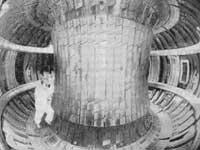Nuclear Fusion: A Step Forward
On 9 and 10 November, the JET (Joinned European Torus) laboratory in Culham (Oxfordshire), England, took another step in controlling nuclear fusion. A mixture of tribos and deuterium produced a thermonuclear reaction of 20 s.
The JET project is the most advanced in the world in fusion energy, promoted by the European Economic Association. The work done by scientists has been for many years and finally what many people saw very difficult has been achieved.
Melting occurs in an extremely hot gas. In this gas the electrons and nuclei of atoms are separated and the plasma is formed. Plasma is electrically neutral. This plasma has special and complex electrical properties, but the impact on the vessel walls can be avoided with suitable electromagnetic fields.

The JET packaging hardly loses magnetic flux and is based on the so-called "tokatuak" design proposed in the Soviet Union. JET scientists have been adjusting the reactor and trying to do so in the last eight years. The conditions that the reactor must meet are very simple. The plasma must be very hot so that the nuclei that come together exceed the electric repulsion.
The plasma temperature should be around 100 million degrees Celsius. The second condition refers to nuclear density in plasma. The density must be large enough for both cores to meet each other in the plasma duration interval. On the other hand, plasma confinement time should also be quite long. It is meant that plasma nuclei must maintain the energy they contain long enough.
JET began work in 1983 and has been slowly improving these parameters. The deuterium-deuterium mergers made with deuterine plasma in the first sessions of the JET were achieved from the beginning. However. The deuterio-tritium fusion is much more effective and is more interesting to obtain fusion energy. The 50% mixture multiplies by 200 the energy obtained from the fusion.
In the session of 9 and 0 November the proportion of tritium oscillated between l 0-15. No more trios have been used to prevent the machine from becoming very radioactive. However, a thermonuclear reaction was achieved often enough to confirm Tel. On the other hand, scientists have shown that they are able to handle tritium smoothly. The tritium is a radioactive tritium, from which it follows that <<\}{\}\}\{\{\}="<unk> <unk> ?{\},{\{\{\{\{\{\{\}\}\}\}\}\}\}\}, specifically, the emitter{\}\}, has an average life of 12.5 years.
The step taken in Culham is very important, but it is still far from commercially using fusion.
Buletina
Bidali zure helbide elektronikoa eta jaso asteroko buletina zure sarrera-ontzian











